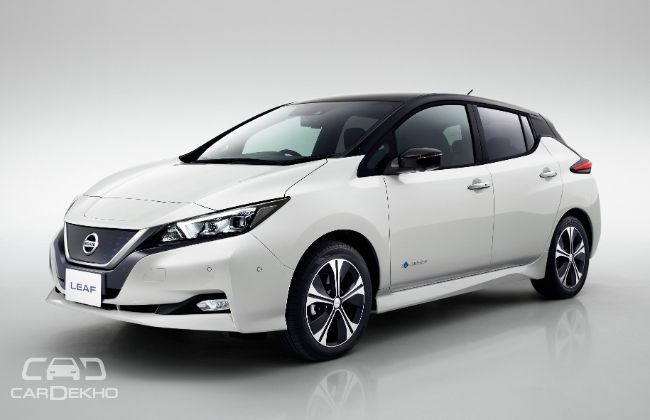Next-Gen Nissan Leaf Breaks Cover

In its new avatar the world’s best-selling electric vehicle is a lot more high tech from just about every angle

Of late, Nissan has been a busy bee. Not only has it bestowed us with teaser images of the all-new Leaf over the past few months, it has also shared some futuristic technological advancements that the car will come with. Well, all that gimmickry will finally stop as the Japanese auto giant has finally taken the wraps off the next-gen model. The new Leaf takes inspiration from its predecessor and cranks it up several notches on almost all fronts.

The new Nissan Leaf is one of those models where the futuristic tech is the area to focus on. Nissan says that it embodies three key aspects of the company’s EV (electric vehicle) design philosophy - intelligent driving, intelligent power and intelligent integration. How intelligent are all these? Let’s find out.
Technology
Encompassing the intelligent driving technology are Nissan’s ProPilot autonomous driving, ProPilot park, e-pedal and the safety shield.

ProPilot Autonomous Driving: This single-lane self-driving feature can follow the vehicle ahead with a speed preset by the driver between 30kmph and 100kmph. If the vehicle in the front stops, the new Leaf will do the same without any input from the driver. If all that is a bit old-school for you, automatic inputs to the steering will keep the car centered in the lane. To remain static after coming to a complete stop the Leaf doesn’t even require manual brake inputs. As soon as the traffic moves the autonomous driving feature can be reengaged by pressing the accelerator lightly or by pressing the defined switch.

ProPilot Park: In other words it is a self-park tech that, once engaged, automatically takes control of the acceleration, braking, handling, shift-changing and parking brakes to guide the car into a parking spot. All this is achieved using a complex combination of 12 ultrasonic sensors and four high-res cameras around the car.

e-Pedal: An e-Pedal comes part of the standard equipment on the all-new Leaf. Simply put, this tech allows starting, accelerating, decelerating, stopping and holding the car by using the accelerator pedal alone. No, the car still comes with a brake pedal for those emergency braking situations. But, Nissan says, studies across Europe, Japan and in the US have shown that the e-pedal will serve well in over 90 per cent of driving needs. Wow!

Safety Shield: Apart from the usual set of safety features like airbags, ABS and EBD, Nissan has garnished the Leaf with a lot more. The kit includes:
- Intelligent Lane Intervention
- Lane Departure Warning
- Intelligent Emergency Braking
- Blind Spot Warning
- Traffic Sign Recognition
- Rear Cross Traffic Alert
- Intelligent Around View Monitor with moving object detection
- Emergency Assist for pedal misapplication
Powerplant

The main talking point for every electric vehicle revolves around the distance that it can cover with a single charge of its onboard batteries. The improved electric motor pumps out 150PS of power and 320Nm of torque. Over its predecessor, that’s 38 per cent and 26 per cent more power and torque respectively. The new 40kWh battery pack gets more energy capacity without increasing its size. That translates to a 67 per cent increase in energy density versus the 2010 model. Even though the powerplant packs more oomph, the lithium-ion battery delivers an estimated range of 400km. That’s astonishing!
If those figures aren’t flattering enough for you, Nissan will also offer a version with more power and longer range in 2018.
Intelligent Integration

If you think what you’ve read before was impressive, this one will surely blow your mind! You must have heard something about NissanConnect before. If not, you can read about it here. However, with the Leaf, Nissan has upped the game. The Leaf can share its onboard power with homes, buildings and power grids. Yes, you read that right!

Using vehicle-to-home technology, the battery makes it possible to store surplus solar power during the daytime and then use it power the home during the darker hours. Moreover, the Leaf can also be programmed to charge during night hours when electricity rates, in some countries, are much cheaper.

Similarly, the vehicle-to-grid tech helps the car to transfer data to power grids and earn incentives for you. Other features include a smartphone app using which one can monitor charging status, find the nearest charging station and pre-heat or pre-cool the car before it’s time to get going.

As of now, Nissan has no plans to introduce the Leaf in India. Apart from the lack of proper EV infrastructure the company will have to import it as a completely built unit (CBU), which will shoot its asking price beyond belief. However the company is expected to an eye out for India’s transformation plan to all-electric transportation by 2030.
This Story has not been edited by ABP News. It has been published through cardekho.com feed directly.
Trending News
Top Headlines






































